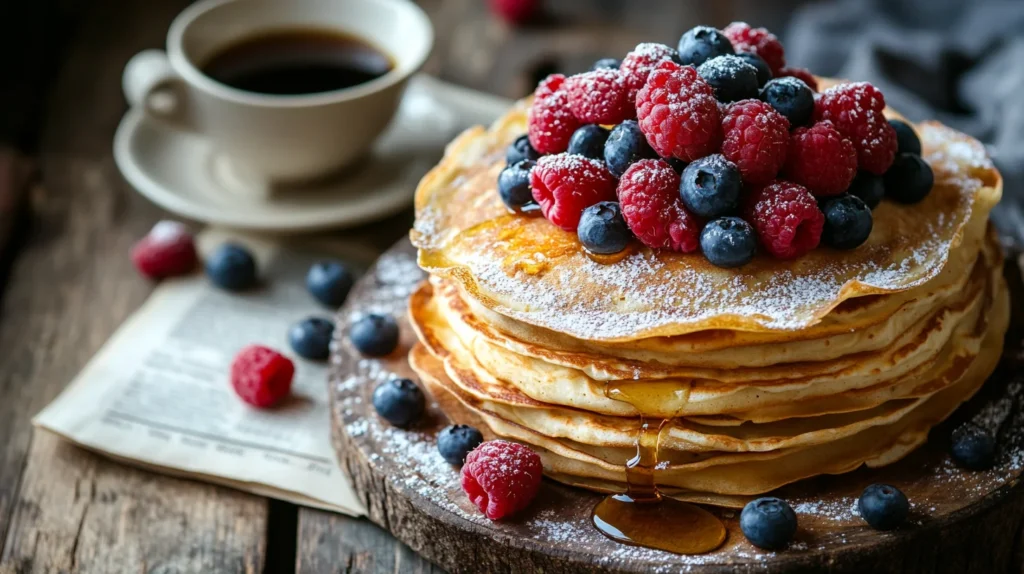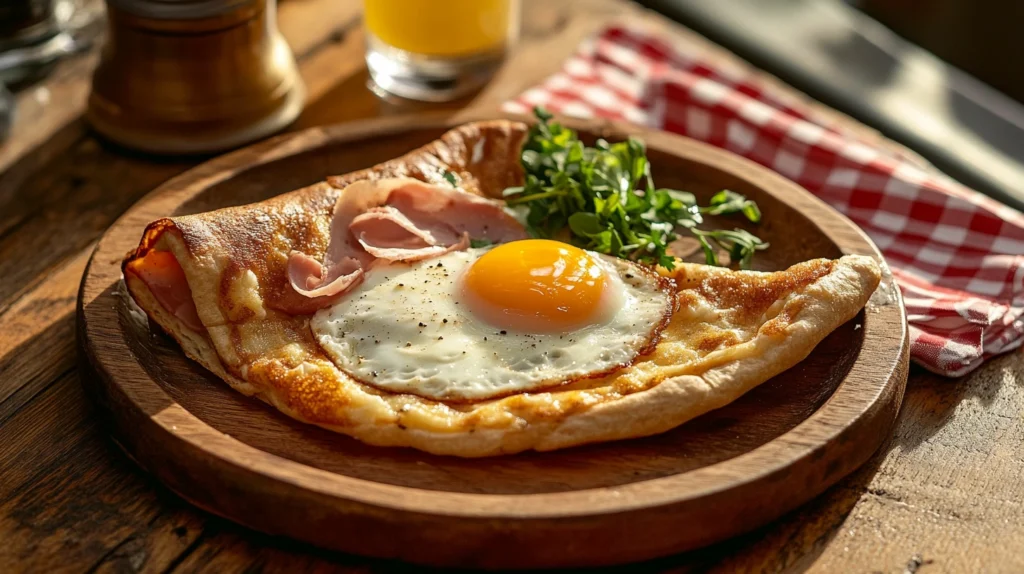Light, delicate, and endlessly versatile, Crêpes de Paris are the very essence of French elegance on a plate. Whether you enjoy them sweet with fruit and chocolate or savory with cheese and ham, these thin pancakes are a beloved staple in Parisian cafés and kitchens alike. In this article, you’ll discover how to recreate authentic Paris-style crêpes at home—with simple ingredients, step-by-step instructions, and tips for the perfect texture and flavor.🥞🥞🥞

The Origins of Crêpes de Paris: From Brittany to the Streets of Paris
How Crêpes de Paris Became a Symbol of French Cuisine
While Crêpes de Paris are now a symbol of Parisian street food and fine dining, their origins can be traced back to Brittany, a region in northwestern France. The story of crêpes begins over a thousand years ago, when locals developed thin, pancake-like creations using buckwheat flour, which was introduced to France from Asia during the Crusades. This led to the creation of galettes, the original savory crêpes, which were often filled with simple ingredients like eggs, ham, and cheese.
Over time, these Crêpes de Paris made their way to Paris, where they became a popular dish among both the working class and the aristocracy. As wheat flour became more accessible and affordable, the sweet crêpe (crêpe sucrée) was born, leading to an explosion of flavors and new recipes. Today, Parisian crêpes have evolved beyond their humble origins, with both traditional and gourmet variations available across the city.
The Role of Crêpes de Paris in French Cuisine
In France, Crêpes de Paris are more than just food—they are a cherished cultural tradition. One of the most famous celebrations associated with crêpes is La Chandeleur, also known as Crêpe Day, which takes place every February 2nd. This holiday, rooted in both religious and pagan traditions, is a time when families and friends gather to make and enjoy crêpes together.
According to tradition, flipping a crêpe in the pan while holding a gold coin in the other hand is believed to bring good luck and prosperity for the year ahead. This fun custom is still practiced by many French households today.
Crêpes de Paris are also a staple at Parisian street markets, cafés, and crêperies, offering locals and tourists a quick, delicious snack on the go. Whether enjoyed as a simple butter-and-sugar treat or an elaborate gourmet dish, crêpes continue to play an essential role in French culinary heritage.
Types of Crêpes de Paris: Sweet and Savory Delights

Crêpes de Paris are beloved for their thin, delicate texture and ability to pair with both sweet and savory ingredients. In Paris, you will find two main types of crêpes:
- Crêpes Sucrées (Sweet Crêpes) – Made with white flour and typically enjoyed as a dessert or snack.
- Galettes Salées (Savory Crêpes) – Made with buckwheat flour and filled with a variety of savory ingredients.
Let’s explore these two delicious variations in detail.
Crêpes Sucrées: The Sweet Side of Crêpes de Paris
Sweet Crêpes de Paris are a staple in Parisian cafés, crêperies, and street vendors. Their versatility allows for countless combinations of toppings and fillings, making them a favorite treat for locals and visitors alike. Here are some of the most popular sweet crêpes you’ll find in Paris:
1. Classic Sugar and Butter Crêpes de Paris
This is the most traditional and simple form of Crêpes de Paris, often referred to as “crêpe au sucre.” It consists of a warm, freshly made crêpe topped with melted butter and a sprinkle of sugar. The simplicity of this crêpe allows the delicate, buttery flavor to shine, making it a timeless favorite.
2. Nutella and Banana Crêpes de Paris
Perhaps the most famous Parisian street food Crêpes de Paris, this indulgent variation features a generous spread of Nutella paired with freshly sliced bananas. The combination of rich chocolate-hazelnut spread and soft, caramelized bananas creates a mouthwatering experience.
3. Crêpes de Paris Suzette
A legendary French dessert, Crêpes Suzette is a flambéed dish featuring crêpes drenched in a buttery orange sauce infused with Grand Marnier or Cointreau. The dish is often prepared tableside at fine-dining establishments, making it a theatrical and luxurious experience.
4. Strawberry and Whipped Cream Crêpes de Paris
For a fresh and fruity twist, many Parisian crêperies serve crêpes filled with sliced strawberries, whipped cream, and a drizzle of chocolate or honey. This crêpe is especially popular in the spring and summer months.
5. Salted Caramel Crêpes de Paris
France is known for its caramel au beurre salé, and it pairs beautifully with warm crêpes. The balance of sweet and salty flavors creates an irresistible taste.
Galettes Salées: The Savory Cousins of Parisian Crêpes de Paris
Unlike sweet Crêpes de Paris, savory crêpes (galettes) are traditionally made with buckwheat flour, which gives them a slightly nutty, earthy flavor. These crêpes are particularly popular in Brittany but are widely enjoyed across Paris.
1. Galette Complète (Ham, Cheese, and Egg)
This is the most iconic savory Crêpes de Paris in France. It consists of a buckwheat crêpe filled with ham, grated cheese, and a sunny-side-up egg. The runny yolk adds a rich, creamy texture, making this a satisfying meal.

2. Smoked Salmon and Crème Fraîche Galette
A gourmet variation, this crêpe features delicate slices of smoked salmon paired with crème fraîche, fresh herbs, and sometimes a squeeze of lemon. It’s a refined yet simple dish that highlights the freshness of French ingredients.
3. Goat Cheese, Honey, and Walnuts Galette
This sweet-savory combination is a favorite among cheese lovers. The creamy goat cheese melts beautifully into the warm crêpe, while honey and walnuts add a delightful crunch and touch of sweetness.
4. Spinach and Mushroom Galette
A popular vegetarian option, this crêpe is filled with sautéed spinach, mushrooms, and a touch of cheese. Sometimes, a poached egg is added for extra richness.
5. Ratatouille Galette
For a taste of classic French Provençal flavors, some crêperies serve a ratatouille-filled galette, packed with roasted eggplant, zucchini, tomatoes, and peppers. It’s a delicious and healthy option for those who enjoy Mediterranean cuisine.
Customization and Regional Variations
One of the best things about crêpes is that they can be customized with endless combinations of ingredients. Some crêperies even offer fusion-style crêpes, incorporating flavors from other cuisines, such as Mexican-inspired crêpes with chorizo and guacamole or Asian-style crêpes with teriyaki chicken and sesame seeds.
Parisian crêpes continue to evolve, but whether you prefer a classic butter-and-sugar crêpe or a gourmet smoked salmon galette, there is always a crêpe to satisfy every craving.
How to Make Authentic Crêpes de Paris at Home
Crêpes are not only a beloved Parisian street food but also an easy and delicious dish that you can make at home. With just a few simple ingredients and the right technique, you can create thin, delicate Crêpes de Paris that rival those served in the best crêperies of Paris.
Essential Ingredients for Perfect Parisian Crêpes
For Sweet Crêpes (Crêpes Sucrées):
- 1 cup (125g) all-purpose flour
- 2 large eggs
- 1 1/4 cups (300ml) milk
- 2 tablespoons melted butter (plus extra for cooking)
- 1 tablespoon sugar
- 1 teaspoon vanilla extract (optional)
- A pinch of salt
For Savory Crêpes (Galettes Salées):
- 1 cup (130g) buckwheat flour
- 1 large eggs
- 1 1/4 cups (300ml) water (or milk for a softer texture)
- A pinch of salt
- 1 tablespoon melted butter
Pro Tip: Let the batter rest for at least 30 minutes (or up to 2 hours) to allow the flour to fully absorb the liquid. This helps create a smoother texture and better flavor.
Step-by-Step Guide to Cooking Crêpes de Paris Like a Pro
1. Prepare the Batter
- In a large mixing bowl, whisk together flour and salt.
- Make a well in the center and add the eggs, milk (or water), melted butter, and vanilla extract (for sweet crêpes).
- Whisk until smooth, ensuring no lumps remain. You can also use a blender for a perfectly smooth consistency.
- Cover the bowl and let the batter rest for 30 minutes. This step is crucial for soft, elastic crêpes.
2. Cook the Crêpes de Paris
- Heat a non-stick crêpe pan or a large skillet over medium heat. Lightly grease it with butter or oil.
- Pour a small ladleful (about 1/4 cup) of batter into the pan, tilting it in a circular motion to spread the batter evenly.
- Cook for about 1 minute, until the edges start to lift and the bottom turns golden brown.
- Flip the crêpe using a spatula (or with a flick of the wrist if you’re feeling adventurous!). Cook for 30-45 seconds on the other side.
- Transfer to a plate and cover with a clean towel to keep warm.
Pro Tip: If the crêpe tears when flipping, your pan might not be hot enough or the batter is too thick. Adjust the heat or add a little more milk to the batter.
3. Add Fillings and Serve
- For sweet crêpes: Sprinkle with sugar and butter, drizzle with Nutella, or fill with fresh fruits and whipped cream.
- For savory crêpes: Add ham, cheese, and a fried egg for a traditional galette complète, or get creative with smoked salmon, goat cheese, or sautéed vegetables.
Secrets for Achieving Perfect Crêpes
Use a well-seasoned crêpe pan – A good non-stick pan makes flipping easier.
Keep the batter thin – It should be the consistency of heavy cream. Add a little milk if it’s too thick.
Cook over medium heat – Too high and the crêpes will burn; too low and they’ll be rubbery.
Flip only when ready – The crêpe should easily release from the pan before flipping.
Stack crêpes with parchment paper – This prevents them from sticking together.
The Best Places to Enjoy Crêpes de Paris
Paris is home to some of the best crêperies in the world, offering both authentic traditional recipes and creative gourmet variations. Whether you’re looking for a quick street crêpe or a sit-down dining experience, the city has a crêperie to satisfy every craving.
Iconic Crêperies to Visit in Paris
1. Breizh Café – The Gourmet Experience
📍 Address: 109 Rue Vieille du Temple, 75003 Paris
⭐ Best for: High-quality ingredients and organic crêpes
Breizh Café is one of the most famous crêperies in Paris, offering authentic Breton-style crêpes with a modern twist. Their galettes are made with 100% organic buckwheat flour, and they source ingredients like artisanal cheeses, cured meats, and premium seafood from the best French producers. Try their “Galette Bretonne” with buckwheat crêpe, smoked herring, and potatoes, or their legendary salted butter caramel crêpe.
2. La Crêperie de Josselin – A Taste of Brittany in Paris
📍 Address: 67 Rue du Montparnasse, 75014 Paris
⭐ Best for: Authentic, hearty crêpes in a cozy atmosphere
Located in the Montparnasse district—known for its strong Breton influence—La Crêperie de Josselin serves some of the most generous and rustic crêpes in Paris. Their galettes are thicker and more buttery than usual, making them incredibly satisfying. The Galette Josselin, filled with ham, cheese, mushrooms, and a fried egg, is a must-try.
3. Au P’tit Grec – The Best Street Crêpes in Paris
📍 Address: 68 Rue Mouffetard, 75005 Paris
⭐ Best for: Large, affordable, and delicious crêpes on the go
If you’re looking for a budget-friendly yet delicious crêpe, Au P’tit Grec is a local favorite. This small crêperie is famous for its huge portions and generous fillings. Their savory crêpes are almost like sandwiches, packed with ingredients such as chicken, cheese, mushrooms, and salad. The sweet crêpes, like banana and Nutella, are just as indulgent.
4. Crêperie Brocéliande – A Hidden Gem in Montmartre
📍 Address: 15 Rue des Trois Frères, 75018 Paris
⭐ Best for: Cozy, family-run atmosphere with amazing homemade crêpes
Located in the charming Montmartre district, Crêperie Brocéliande is a hidden gem loved for its freshly made crêpes, friendly service, and cozy ambiance. Their crêpes are light, crispy, and full of flavor. Try the goat cheese and honey galette, or their signature Crêpe Belle-Hélène, made with poached pear, chocolate, and vanilla ice cream.
5. La Droguerie – A Quick and Tasty Street Crêpe
📍 Address: 56 Rue des Rosiers, 75004 Paris
⭐ Best for: Fast service and crispy, flavorful crêpes
Located in the historic Le Marais district, La Droguerie is a tiny crêpe stand known for its thin, crispy crêpes made fresh to order. It’s the perfect place to grab a quick bite while exploring the city. Their butter-sugar crêpe is simple yet divine, and their ham, cheese, and mushroom galette is a delicious savory option.
What Makes a Parisian Crêperie Special?
- Authenticity: The best crêperies use high-quality ingredients like organic buckwheat flour, real French butter, and farm-fresh eggs.
- Traditional Techniques: Some crêperies stick to time-honored Breton recipes, ensuring an authentic taste.
- Creative Twists: Many modern crêperies experiment with unique flavors and international influences.
- Atmosphere: Whether it’s a street food stand or a cozy café, the experience of eating crêpes in Paris is always magical.
The Art of Eating Crêpes de Paris Like a Local
Crêpes are not just food in Paris—they are a cultural experience. Whether you’re walking along the Seine with a crêpe in hand or enjoying a galette in a cozy café, there is a certain charm to eating crêpes in the French capital. To fully embrace the Parisian crêpe tradition, it’s important to know where, how, and when to eat them.
Street Food Culture: The Joy of Eating Crêpes on the Go
One of the most iconic ways to enjoy crêpes in Paris is from a street vendor. You’ll find them in popular spots like the Latin Quarter, Montmartre, near the Eiffel Tower, and Le Marais. Parisians often eat crêpes folded in hand, like a sandwich—perfect for a tasty, mess-free treat while strolling the city.
The Experience of Dining in a Parisian Crêperie
For a more traditional experience, visiting a sit-down crêperie is a must. Parisians love to gather in these small, often family-run establishments to enjoy a meal of savory galettes and sweet crêpes, typically paired with a glass of cider.
Table Etiquette: In a restaurant, crêpes are served flat on a plate with a fork and knife, rather than folded like street crêpes.
Pairing Drinks: Instead of wine, Breton cider (cidre) is the classic drink to accompany galettes. It’s slightly sweet, slightly tart, and perfectly complements the earthy flavors of buckwheat crêpes.
Course Order: Many Parisians order a savory galette first, followed by a sweet crêpe for dessert—a classic crêperie meal.
Pairing Crêpes de Paris with the Perfect Drink
The right drink can elevate your crêpe experience. Here are some popular pairings:
🥂 Breton Cider (Cidre) – The traditional drink for savory crêpes, with a crisp, slightly tangy taste.
☕ Coffee (Café Crème or Espresso) – Perfect for pairing with a sweet crêpe in the morning or afternoon.
🍷 White Wine (Chardonnay or Sauvignon Blanc) – A sophisticated option for more gourmet crêpe variations.
🍵 Tea or Hot Chocolate – Great for a cozy, comforting crêpe experience, especially in winter.
When Do Parisians Eat Crêpes?
While crêpes can be enjoyed anytime, there are a few special occasions when they are especially popular:
Breakfast & Brunch – A light and delicious way to start the day.
Snack Time (Goûter at 4 PM) – Many Parisians grab a sweet crêpe in the afternoon as a treat.
La Chandeleur (Crêpe Day on February 2nd) – A national celebration where families and friends make and eat crêpes together.
Late-Night Snack – Some crêperies stay open late, making them a favorite after-party snack!
Crêpes: A Symbol of Parisian Simplicity & Elegance
Whether you enjoy them hot off a street vendor’s griddle or served elegantly in a Parisian café, crêpes are a quintessential part of French culture. They embody the simplicity, elegance, and culinary excellence that Paris is known for.
Croque Monsieur Recipe – Classic French Sandwich
→ This could be linked when discussing French café culture or classic Parisian breakfast items.Mini Apple Pies Recipe: Easy, Flaky & Delicious Bite-Sized Treats
→ Ideal for linking under a dessert section, comparing crêpes to other pastry-based French treats.Chicken and Shrimp Carbonara – Creamy, Flavorful & Easy Recipe
→ While carbonara is Italian, this can be linked when discussing savory variations of crêpes, such as seafood crêpes.
Frequently Asked Questions
1. What are some fun facts about crêpes?
Crêpes are over 1,000 years old – They originated in Brittany, France, in the 12th century.
There is a holiday dedicated to crêpes – La Chandeleur (Crêpe Day) is celebrated on February 2nd in France.
Flipping a crêpe can bring good luck – Tradition says that if you flip a crêpe while holding a coin in your other hand, you will have good fortune for the year.
Crêpes can be sweet or savory – Sweet crêpes (crêpes sucrées) are made with wheat flour, while savory crêpes (galettes) are made with buckwheat flour.
The world record for the largest crêpe – The biggest crêpe ever made was 15.6 meters (51 feet) in diameter!
2. Who owns Crêpes de Paris?
There are multiple crêperies and restaurants around the world named “Crêpes de Paris.” Ownership depends on the specific location. Some are family-owned French-style cafés, while others are franchise chains in different countries. Would you like me to find information about a specific one? 😊
3. What are crêpes called in France?
In France, crêpes are simply called “crêpes” for sweet varieties and “galettes” for savory ones.
- “Crêpes sucrées” (Sweet crêpes) – Made with wheat flour and typically served with sugar, Nutella, or fruit.
- “Galettes salées” (Savory crêpes) – Made with buckwheat flour and filled with ingredients like cheese, ham, and eggs.
In Brittany, crêpes are sometimes referred to as “Krampouezh”, which is the Breton word for them.
4. How much does a crêpe cost in Paris?
The price of a crêpe in Paris varies depending on where you buy it:
- Street Crêpes (Food Stands): €3 – €6 (simple sugar, Nutella, or jam crêpes).
- Café & Crêperie Crêpes: €7 – €15 (with gourmet ingredients like fresh fruit, ice cream, or specialty cheeses).
- Luxury Crêpes (Fine Dining Restaurants): €15 – €25 (such as Crêpes Suzette flambéed with Grand Marnier).
Conclusion
Crêpes de Paris are more than just a recipe—they’re a culinary tradition that brings a little taste of France into your home. Now that you know how to make them from scratch, you can enjoy them any time—whether for breakfast, brunch, dessert, or even a savory dinner. Keep the base simple, get creative with the fillings, and most importantly, enjoy every bite.
Bon appétit! 🥞🥞

Crêpes de Paris: Classic French-Style Crêpes
Equipment
- Mixing bowl (for batter)
- Whisk or blender (for smooth consistency)
- Non-stick skillet or crêpe pan
- Ladle or measuring cup (for pouring batter)
- Spatula (for flipping crêpes)
- Cooling rack (optional, for resting crêpes)
Ingredients
- For the Crêpes Batter:
- 1 cup all-purpose flour sifted
- 2 large eggs
- 1 ¼ cups whole milk
- 2 tbsp melted butter plus extra for greasing
- 1 tbsp granulated sugar omit for savory crêpes
- ½ tsp vanilla extract for sweet crêpes
- ¼ tsp salt
- Optional Sweet Fillings:
- Nutella & bananas
- Strawberries & whipped cream
- Lemon & powdered sugar
- Berry compote & cream cheese
- Optional Savory Fillings:
- Ham & Gruyère cheese
- Sautéed mushrooms & spinach
- Smoked salmon & cream cheese
Instructions
- Step 1: Prepare the Batter
- In a mixing bowl, whisk together flour, sugar (if using), and salt.
- In another bowl, beat eggs, milk, vanilla (for sweet crêpes), and melted butter.
- Gradually whisk wet ingredients into dry ingredients until smooth.
- Alternatively, blend all ingredients for 30 seconds for a lump-free batter.
- Let the batter rest for 15–30 minutes at room temperature (optional but recommended for best texture).
- Step 2: Cook the Crêpes
- Heat a non-stick skillet or crêpe pan over medium heat and lightly grease with butter.
- Pour ¼ cup batter into the pan, swirling to coat the bottom in a thin, even layer.
- Cook for 60–90 seconds until the edges lift and the bottom is lightly golden.
- Flip with a spatula and cook for another 30 seconds.
- Transfer to a plate and repeat with remaining batter.
- Step 3: Serve & Enjoy
- Fill with your favorite sweet or savory toppings, fold, and serve warm!
Notes
Make it dairy-free by using almond or oat milk and coconut oil instead of butter.
Store leftovers in the fridge for up to 2 days or freeze for up to 2 months with parchment paper between crêpes.
Reheat in a pan over low heat or in the microwave for 15 seconds.

